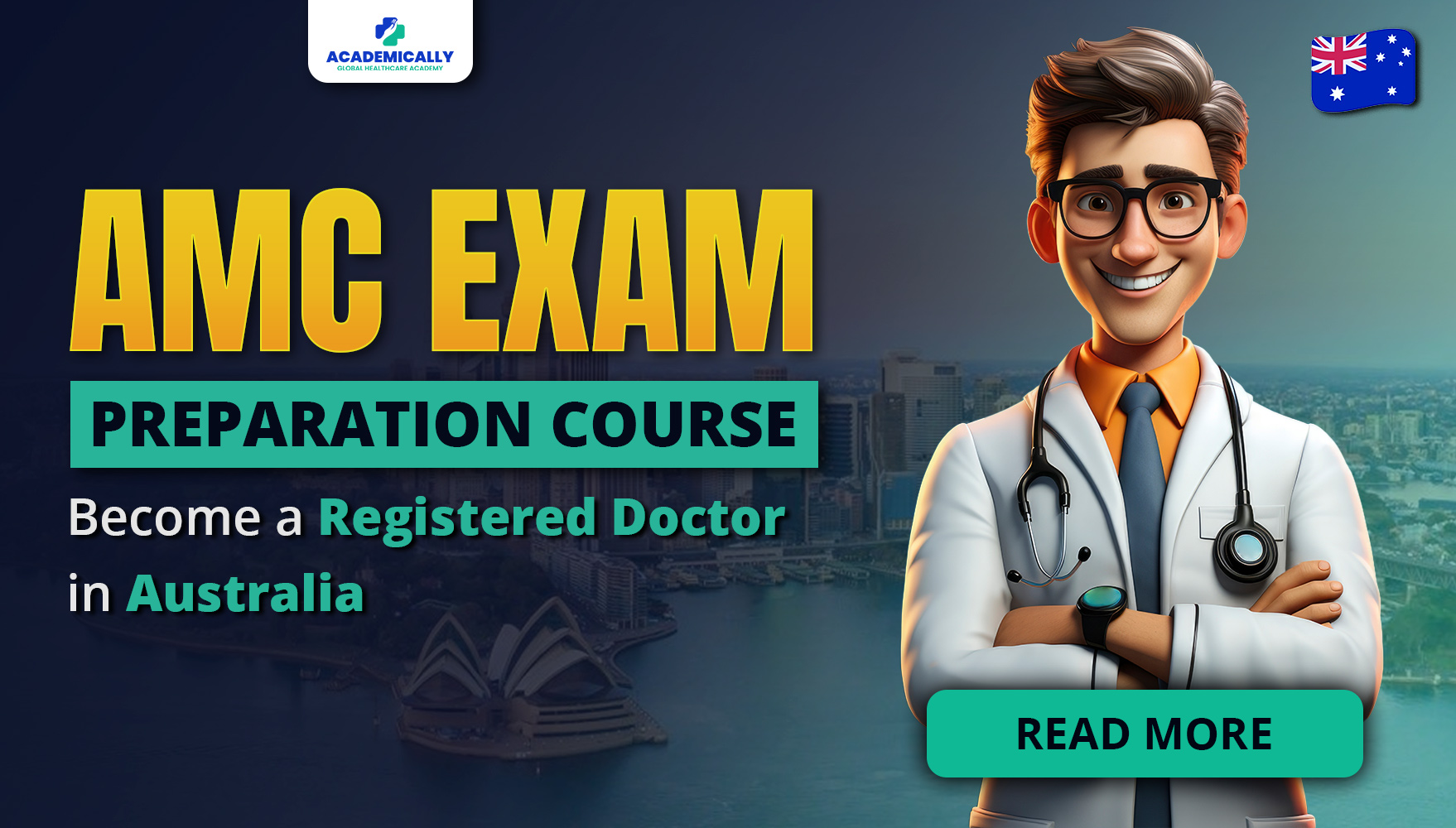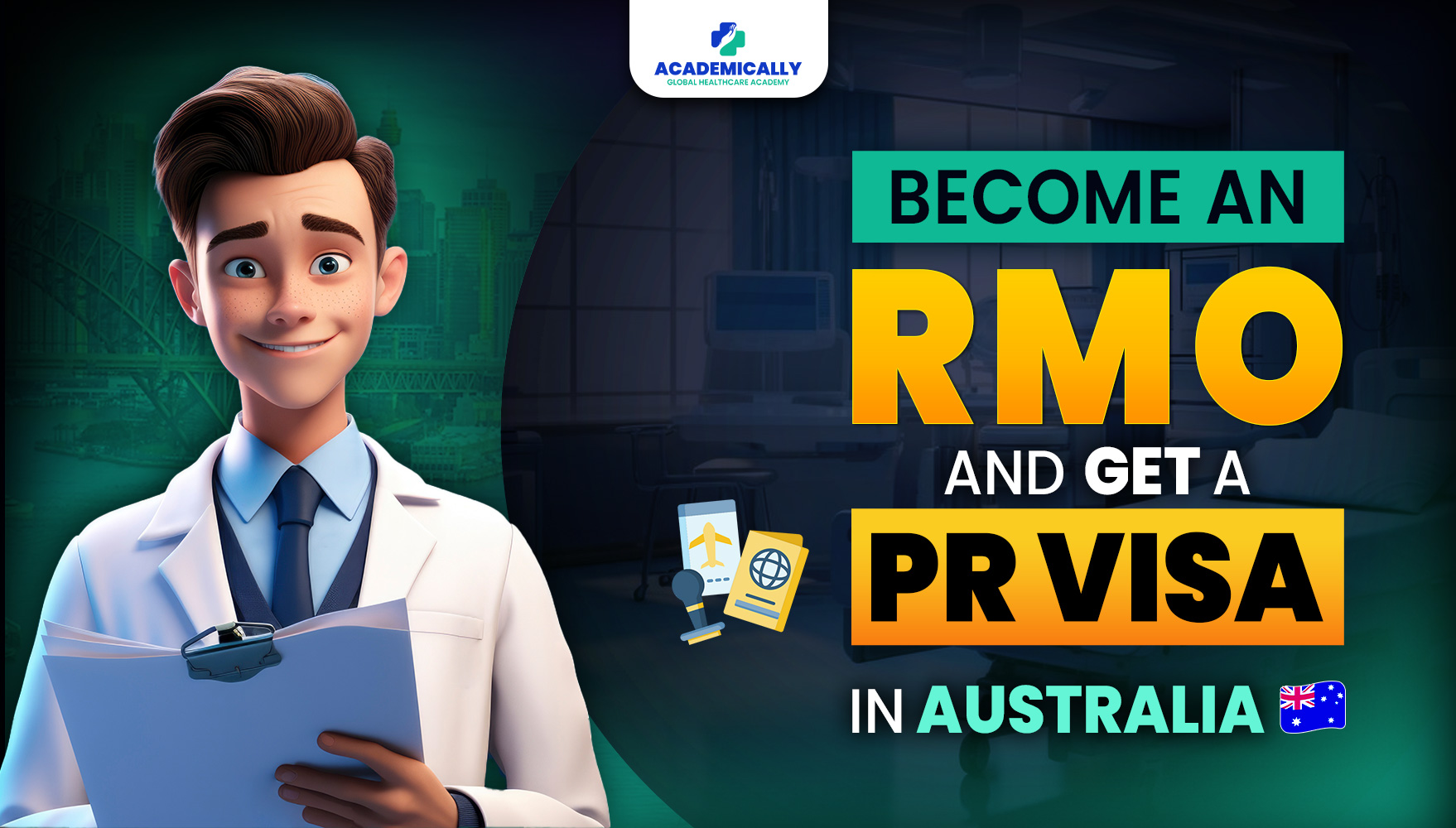Steps to becoming an RMO in Australia
Becoming an RMO (Registered Medical Officer) in Australia as an international medical graduate (IMG) involves several steps and requirements, including passing the Australian Medical Council (AMC) exams and demonstrating English language proficiency. Here's an outline of the process:

Steps to becoming an RMO in Australia
Step 1: Take Skills Assessment
Step 2: Prove your English Language Proficiency (IELTS/OET/PTE)
Step 3: Get EPIC/ECFMG Verification
Step 4: Clear AMC-1 and AMC-2
Step 5: Apply for Medical Registration with the Medical Board of Australia (MBA)
Step 6: Gain work experience
Step 7: Apply for RMO role
Skills Assessment
IMGs must assess their eligibility for medical registration in Australia through the Australian Medical Council (AMC). It includes
- A recognised medical degree such as MBBS/MD/MS from an AMC-recognised university (typically 4.5 years of study).
- Completion of a compulsory rotatory internship following the medical degree.
- Holding full and unrestricted registration in your home country or the country of medical training without any history of registration withdrawal.
English Language Proficiency (IELTS/OET/PTE)
IMGs must demonstrate proficiency by undertaking an English language test. The accepted tests include the International English Language Testing System (IELTS), the Occupational English Test (OET), and the Pearson Test of English Academic (PTE Academic).
P.S- You can take the English proficiency test even after passing the AMC-1.
EPIC/ECFMG Verification
IMGs must ensure that the Educational Commission verifies their medical qualifications for Foreign Medical Graduates (ECFMG) and get registered in it.
ECFMG collaborates with the Australian Medical Council (AMC) to authenticate the medical qualifications of internationally educated physicians seeking to practice medicine in Australia.
Suppose you graduated from a medical institution outside Australia and intend to register with the Medical Board of Australia or undergo specialist assessment by an Australian medical college. In that case, you must have all necessary credentials verified through EPIC as part of your application process.
AMC-1 and AMC-2 Exams
Then, the next step for IMGs is to pass the AMC exams, which consist of the following components:
- AMC Multiple Choice Question (MCQ) Exam: This exam assesses medical knowledge and clinical reasoning.
- AMC Clinical Exam: This exam evaluates clinical skills, including history-taking, physical examination, and patient communication.
Applying for Medical Registration
Once IMGs have completed the necessary exams and met all requirements, they can apply for medical registration with the Medical Board of Australia (MBA). The MBA is the regulatory authority responsible for overseeing medical registration in Australia.
Gain work experience
After obtaining medical registration, it is advisable to gain some work experience in a relevant clinical setting. This could include undertaking internships or other supervised positions to develop further your clinical skills and familiarity with the Australian healthcare system.
Apply for an RMO role
With the requisite qualifications, assessments, and registration in place, aspiring RMOs can then apply for positions as Resident Medical Officers in hospitals or healthcare facilities across Australia. These roles provide valuable hands-on experience and are often a stepping stone to further specialisation or career advancement within the medical field.
Visas for RMO
After passing the AMC examination and registering with the board, the doctors get a temporary visa to practise in Australia. They can apply for permanent residency by checking the Short-term Skilled Occupation List (STSOL).
Occupations listed on the Short-term Skilled Occupation List (STSOL) are in high demand in Australia. Doctors can apply for Australia-sponsored Permanent Residency (subclass 190) with an invitation or sponsorship from the state government.
For doctors on the STSOL, the following visa subclasses may be applicable:
- Skilled Nominated visa (subclass 190)
- Training visa (subclass 407)
- Skilled Work Regional (Provisional) visa (subclass 491) - State or Territory nominated
- Temporary Skill Shortage visa (subclass 482) - Short-term stream
- Skilled Employer Sponsored Regional (Provisional) visa (Subclass 494
PR Pathway for RMO
To apply for visa subclass 190 or subclass 491, you'll need a nomination from the state or territory government where you plan to live and work. Each state and territory has requirements that must be met to receive this nomination.
The subclass 190 visa is a permanent visa. In contrast, the subclass 491 visa allows you to live and work in regional Australia for five years with a pathway to permanent residency through the subclass 191 visa.
One key difference between the two visas is that you can only apply for the subclass 491 visa if you are living and working in regional areas in Australia, whereas this is not a requirement for the subclass 190 visa.
Skilled Visa Assessment
Medical professionals seeking migration to Australia must undergo a skills assessment to demonstrate that their qualifications and work experience meet Australian standards.
To apply for the visas mentioned earlier, a positive Skills Assessment is required in most cases unless exempted under specific circumstances.
The Skills Assessment Authority is the Medical Board of Australia (MBA) for Resident Medical Officers. Meeting the criteria for a positive skills assessment involves getting a standard pathway.
Standard Pathway is designed for IMGs seeking general registration, this pathway mandates having a primary medical qualification recognised by the Australian Medical Council and World Directory of Medical Schools. There are two types within this pathway: AMC Examination and Workplace-based Assessment, both requiring completing 12 months of supervised practice in an approved position.
Points-Based Immigration System
Calculating your points for skilled visas is crucial for determining your application eligibility. While the minimum required score is 65 points, depending on factors like your occupation, competition, and preferred states, you may need to aim for a higher score to increase your chances of receiving an invitation.
Points are awarded based on various criteria, including:
- Age: Points are allocated based on your age at the time of application.
- Educational Qualifications: Points are awarded for your highest level of educational attainment.
- Professional Year: Additional points can be earned if you have completed a Professional Year program in Australia.
- English Proficiency: Points are given based on your proficiency in the English language, measured through standardised tests like IELTS or TOEFL.
- Regional Study: Additional points are available if you have completed a qualification in a regional area of Australia.
- Work Experience: Points are awarded based on relevant work experience in your nominated occupation.
- Specialist Educational Qualifications (STEM): Additional points can be earned if you have qualifications in Science, Technology, Engineering, or Mathematics (STEM).
- Partner Skills: Points may be awarded if your partner meets certain criteria, such as qualifications or work experience in a relevant occupation.
Role of Resident Medical Officer (RMO)
A Resident Medical Officer (RMO) plays a vital role in diagnosing, treating, and preventing physical and mental health conditions while working under the supervision of experienced medical specialists or senior general practitioners. This profession requires proper registration or licensing.
Key tasks performed by a Resident Medical Officer include
Assessing Patients: Conducting thorough examinations and interviews with patients to identify their health issues and documenting their medical history.
Diagnostic Procedures: Ordering and interpreting laboratory tests, X-rays, and other diagnostic tests to aid in accurate diagnosis.
Patient Care: Providing comprehensive care by prescribing and administering treatments, medications, and other necessary interventions.
Monitoring Progress: Regularly monitoring patients' progress and response to treatments to ensure effective management of their health conditions.
Health Promotion: Advising patients on healthy lifestyle habits, including diet, exercise, and preventive measures to promote overall well-being.
Referrals: Collaborating with specialist medical practitioners and referring patients to specialised care when needed.
Reporting: Reporting relevant health information such as births, deaths, and notifiable diseases to the appropriate government authorities.
Hospital Admissions: Coordinating and arranging the admission of patients to hospitals when further medical care or observation is required.
To Sum It Up
The journey to becoming a Resident Medical Officer (RMO) and securing a Permanent Residency (PR) Visa in Australia is an attainable goal for international medical graduates (IMGs).
By carefully navigating through the required steps, including obtaining recognised medical qualifications, gaining relevant work experience, securing a job offer, and meeting the necessary skills assessment and visa requirements, individuals can fulfil their aspirations of practising medicine in Australia and establishing a long-term career in the country's esteemed healthcare system.
Remember that no goal is beyond reach with the proper determination, dedication, and aspirations. No matter how daunting, every task can be accomplished with passion and a clear vision. As long as you harbour the desire and dream to succeed, there are no limits to what you can achieve.
Fill up this form for a free one on one counselling session.




